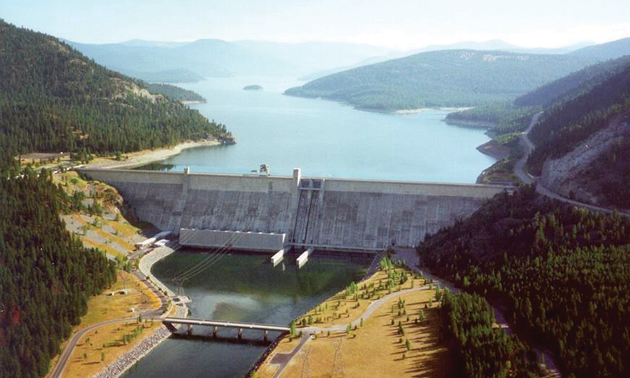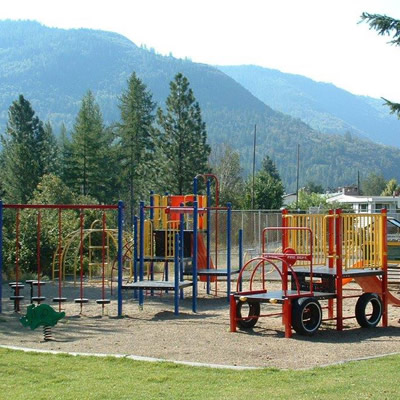USA–Canada coordinate operations to manage flood risk in the Kootenai River Basin

Portland, Ore.–Current snowpack levels across the Kootenai (spelled Kootenay in Canada) River Basin are above normal for this time of year, contributing to above-normal spring runoff forecasts on both sides of the border. The U.S. Army Corps of Engineers’ current spring runoff forecast at Libby Dam for the April–August 2014 period is 7.0 Million acre-feet (MAF), or 119 percent of the average runoff that occurred during the 1981–2010 period. For comparison, the actual April–August runoff at Libby Dam during 2012 and 2013 was 9.186 MAF and 7.173 MAF, respectively. BC Hydro’s current forecast of Kootenay Lake local runoff for April–August 2014 is 109 percent of normal, whereas actual runoff in 2012 and 2013 was 149 percent and 111 percent of normal, respectively.
Operations of Libby Dam are coordinated under the Columbia River Treaty to provide flood risk management for the U.S. and Canadian portions of the Kootenai River Basin. Cooler temperatures and precipitation in early May have maintained the snowpack across much of the basin, while some snowmelt has begun in lower elevation areas. Based on this runoff information and planned reservoir operations at Libby Dam, the latest projections indicate a 17 percent chance of exceeding flood stage at Bonners Ferry, Idaho, which is 1,764 feet. While unusually high spring rainfall may increase flood risk, there is currently a low likelihood of river stages at Bonners Ferry, Idaho, reaching levels seen in June–July 2012, when the river peaked at 1,766.5 feet. Flow and stage projections are based on National Weather Service ensemble forecasts and are updated frequently during runoff season. To see the latest forecast modeling for Libby Dam operations, visit: 1.usa.gov/1kP1lSH.
On the Canadian side, BC Hydro drafted Duncan Reservoir to its minimum reservoir level in late April, and the reservoir recently began to gradually refill. Releases from Duncan Dam into Kootenay Lake will be reduced to minimum during the peak Kootenay Lake inflow. FortisBC and BC Hydro have coordinated operations to maximize the discharge from Kootenay Lake (limited only by the channel restriction at Grohman Narrows) since mid-March, and this operation will continue until after the lake level has peaked (likely in June). Due to the above-normal snowpack conditions, the peak Kootenay Lake level in 2014 also is expected to be above normal, with a 20 percent likelihood of reaching 1,752 ft. At this time, there is a low likelihood (less than 3 percent) of the lake level reaching 1,753.8 ft (peak level in 2012).
The Corps of Engineers and BC Hydro will host public meetings in the basin during the last week of May and early June to discuss planned reservoir operations. The first meeting will be held on May 28, from 6 pm to 9 pm, at the Baynes Lake Community Centre (468 Jaffray Baynes Lake Road, Baynes Lake, BC). The second meeting will be held on May 29 in Bonners Ferry, Idaho, at the Kootenai River Inn (7169 Plaza Street, Bonners Ferry, Idaho) from 6 pm to 8 pm. The third meeting will be held on June 9 in Eureka, Mont. at the Lincoln Electric Cooperative (500 Osloski Road, Eureka, Mont.) from 6pm to 8 pm. The final meeting will be held on June 11 at the Lincoln County Credit Union (714 West 6th Street, Libby, Mont.) from 7 pm to 9 pm.
Kootenay Basin Water Levels Update
May 2014
Columbia River Treaty
As a result of the Columbia River Treaty, British Columbia and its neighbours in Washington, Oregon, Idaho and Montana benefit from co-ordinated management of their dams to generate power and manage flood risk. BC Hydro and the US Army Corps of Engineers work very closely with each other to share information about reservoir operations to ensure the effectiveness of overall flood risk management in the Columbia basin. Prior to construction of the Treaty dams, the Columbia River was subject to high flood risks and resulting damage to communities.
Flood Conditions in 2012
During 2012, very high runoff conditions in the Columbia/Kootenay basin resulted in high water levels, and some flooding damage, at locations throughout the basin. Without the benefit of large reservoir management on both sides of the border, the damage would have been far greater. At Kootenay Lake, water levels would have been 6.6 feet higher without the upstream Libby and Duncan dams. Prior to the existence of these facilities, the runoff into Kootenay Lake was unregulated. In addition, FortisBC and BC Hydro actively coordinate to maximize releases from Kootenay Lake (at Corra Linn and Kootenay Canal) during the freshet season, thus keeping the peak lake level as low as possible.
Current Situation and Activities
At present, most attention is on the Kootenay basin and, in particular, impacts to Bonners Ferry (US) and Kootenay Lake. The May 2014 snowpack levels and seasonal runoff forecasts for the basin are above normal, but substantially lower than actual 2012 runoff values. There is a high likelihood (~80%) that Kootenay Lake levels will exceed 1750 ft (flood concern threshold) and an above-normal likelihood (~20%) that levels will reach 1752 ft (significant flood damage). There is a very small chance (< 3%) of the 2014 lake level reaching the 2012 peak level of 1753.8 ft -- the highest in 38 years.
Keeping stakeholders informed
BC Hydro strives to keep local governments, First Nations, businesses, non-governmental organizations, and stakeholders informed about reservoir and river operating conditions for the Columbia and Kootenay systems. With the assistance of the US Army Corps of Engineers, BC Hydro hosted conference calls on April 23, 2014 to provide information regarding spring/early summer forecasts for the Columbia and Kootenay systems.
About BC Hydro
BC Hydro has been providing clean, reliable power to British Columbians for more than 50 years while maintaining among the lowest rates in North America. BC Hydro is a provincial Crown corporation that serves 1.9 million customers and invests in the electrical system and in energy conservation to deliver a safe and reliable supply of electricity for today’s customers and for generations to come.





Comments